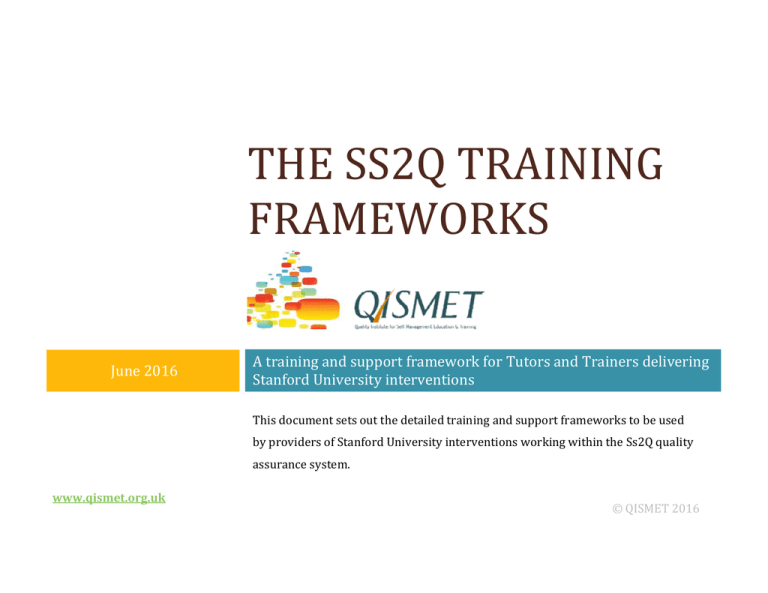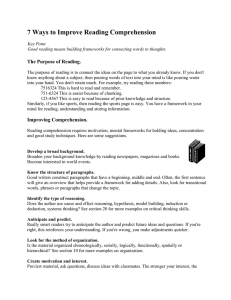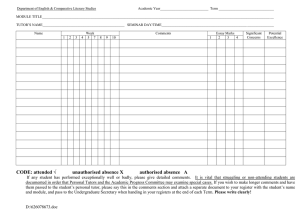The Ss2Q Training Frameworks
advertisement

THE SS2Q TRAINING FRAMEWORKS June 2016 A training and support framework for Tutors and Trainers delivering Stanford University interventions This document sets out the detailed training and support frameworks to be used by providers of Stanford University interventions working within the Ss2Q quality assurance system. www.qismet.org.uk © QISMET 2016 The Ss2Q Training Frameworks The Ss2Q Training Frameworks Contents 1 Foreword 2 2 Ethos behind training and accreditation process 4 3 The revised training and support frameworks 6 4 Appendices Aims and objectives of Ss2Q Revision Steering Group Glossary 18 Page 1 The Ss2Q Training Frameworks 1. Foreword Background to Ss2Q ‘Stepping Stones to Quality’ – Ss2Q for short – is a straightforward and practical self-assessed quality assurance tool. Its purpose is to ensure that all lay led self management programmes covered by Stanford licenses are implemented consistently and effectively to benefit of people living with long term conditions. It was created by a cross sector coalition of organisations and people living with long term conditions to support the expansion of lay led self management programmes within a set of agreed minimum requirements of good practice. Ss2Q is a structured self-assessment tool and is the first step towards gaining independent verification through the QISMET Certification process http://qismet.org.uk/certification/ Ss2Q is built on the four stepping stones to success for a Stanford self-management programme: STEP 1: Adhere to the core values and principles of lay led self management programmes STEP 2: Generate support for your programme within your organisation and the communities you serve STEP 3: Identify a self management coordinator STEP 4: Recruit, train and support people living with long term conditions, and those who care for them, to deliver lay led self management programmes Page 2 The Ss2Q Training Frameworks Updating the training and support frameworks The process for training and accreditation of deliverers (referenced within Step 4 of Ss2Q) was originally developed by Arthritis Care in the mid 1990’s; building upon the basic licensing and training requirements of Stanford University.1 The training frameworks were further enhanced by the NHS Expert Patients Programme, which provided independent capacity building support to Stanford providers from 2001 – 2007. It was anticipated that the training frameworks would continue to be updated by an independent capacity building body. This expectation failed to materialise after the establishment of the Expert Patients Programme Community Interest Company (EPP CIC) in 2007. An update of the training and support frameworks to reflect changes in practice largely driven by the post-recession commissioning environment was needed. A Steering Group, led by Talking Health Taking Action was established by QISMET during 2015 with the task of updating the training and support frameworks (see appendix one for Steering Group aims and objectives). This report contains the updated training and support frameworks and should be used as a companion document when completing the Ss2Q self-assessed quality assurance framework, which can be downloaded at http://qismet.org.uk/certification/ss2q-certification/ Acknowledgements Thank you to everyone that contributed to the production of the revised training and support framework including QISMET, Talking Health Taking Action, members of the Steering Group, members of the Reference Group and everyone that participated in the online survey. 1 http://patienteducation.stanford.edu/licensing/ Page 3 The Ss2Q Training Frameworks 2. The training and accreditation ethos The Ss2Q training and accreditation frameworks are based upon an apprenticeship model which means that training and support is provided by someone who has already been through the process. They are designed to provide training and support to people living with long-term conditions who are, for the most part, delivering in a voluntary rather than a professional capacity. To understand the ethos behind the training processes within Ss2Q, one needs to understand the rationale underlying the initial development of lay led self-management programmes within the UK voluntary sector. For Arthritis Care, the originators of the training framework, use of the Stanford course was primarily to provide an opportunity for people living with long-term conditions to gain important skills and to experience feelings of self worth, dignity and validation by supporting others in a similar position to make changes to the way in which they manage their condition on a daily basis.3 Well resourced recruitment, training, accreditation and support process were considered a long-term worthwhile investment to complement the six-week CDSMC in enabling people take control of their life while living with a long-term condition. 2 3 Assumptions underlying recruitment, training and accreditation processes in Ss2Q 1 Apprenticeship model; everyone starts as a Tutor and progresses up the training ladder 2 Tutors will be recruited from the ranks of people living with long-term conditions and those who care for them 3 There is active recruitment of people that have had to make significant life changes due to living with a long-term condition 4 People living with long-term conditions often need to establish new roles for themselves, will have low self-confidence, may have been unemployed for some-time and will need support to deal with the emotional fall out of living with a long-term condition 5 Courses will be lay led. In other words, the people delivering the courses do so as a person living with a long-term condition, not in any professional capacity 6 Tutors will be appropriate role models and representative of the group they are delivering to 7 Well resourced recruitment, training, accreditation and support processes are essential to supporting people develop confidence and skills and a journey back into a ‘helper role’ rather than someone who is always in receipt of ‘help’ from others2 ibid Thompson, J. MBE. The principles of lay leadership in Jones, F.R. Self-management courses the thoughts of participants, planners and policy makers. Oxford University Press, 2010. Page 4 The Ss2Q Training Frameworks From Tutor to Trainer of Lead Trainers There are four levels of competency among Tutors and Trainers delivering Stanford University programmes within Ss2Q: Each of the above stages must be completed before moving onto the next level of competency. Page 5 The Ss2Q Training Frameworks 3. The revised training and support frameworks The process which guided the revision of the Ss2Q training frameworks is set out in appendix one. The training frameworks will provide those tasked with managing, training and supporting deliverers of Stanford interventions with guidance that we hope is free from ambiguity and fit for purpose for many years to come. The key difference between the training and support frameworks contained within and their predecessors is that the content is less focused on the detail of organisational processes and more focused on the number of hours of training and delivery needed by deliverers to gain and maintain accreditation, and the means by which organisations are able to demonstrate that the specified requirements have been met. The new frameworks also follow the Stanford fidelity convention of Must Do’s and Nice to Do’s. The Ss2Q training and support frameworks should be used in conjunction with the Ss2Q quality framework and audit tool which can be downloaded at http://qismet.org.uk/certification/ss2qcertification/ Page 6 The Ss2Q Training Frameworks SELF-MANAGEMENT TUTORS Role Description: To deliver lay led self-management courses PROCESS RECRUITMENT MUST DO Transparent recruitment process. NICE TO DO Attendance at a six-week course. DBS checks and induction. COMMENT To recruit a diverse and representative cohort of people from local communities. Useful to include Co-ordinator and experienced Tutor on recruitment panel. TRAINING Attend standardised training course (24 hours delivered by two Lead Trainers). Attend as an observer prior to training. To be aware of development and ethos of the Programme. Feedback to sponsoring organisation. Tutor details entered on organisational register. DELIVERY To gain familiarisation with the CDSMC Manual. To develop skills and practice delivery. Deliver minimum of two courses in 12 months and gain accreditation within 18 months. First course delivered within three to six months of training. Unsuccessful assessment requires a repeat assessment within 12 months of training. Unaccredited Tutors deliver with accredited Tutors. Options for refresher training within 12 months (min six-hours). Gain accreditation within 12 months of training. To build on the initial training and to gain confidence and expertise through delivery. Refresher training to be offered through supervision or full/partial attendance at Tutor training must include observed practice delivery. Page 7 The Ss2Q Training Frameworks PROCESS ACCREDITATION MUST DO NICE TO DO Certificate issued on successful completion of 1st and 2nd assessment by training organisation once training organisation has received copies of 1st and 2nd assessment. COMMENT To build capacity in communities and ensure consistent practice. Sponsoring organisation and Tutor to hold Passport to Practice (P2P) record. Name and accreditation details to be recorded by sponsoring organisation. ONNGOING Deliver minimum of one course annually. Monitoring visit every 18 months. Attend one Tutor supervision delivered by a Lead Trainer every 18 months. Deliver minimum of two courses annually. Cement skills in further delivery of courses. Monitoring visit every 12 months. Use Tutor training and experience as a stepping stone to other opportunities including Assessor and Lead Trainer (Note: Not all sponsoring organisations have capacity to progress Tutors to Assessor, Lead Trainers). Attend Tutor supervision delivered by a Lead Trainer every 12 months. Attend internal training and support sessions within sponsoring organisation when available. Discuss alternative options with sponsoring organisation. Supervision is required with group of peers for minimum of six-hours which includes skill update and practice delivery. Page 8 The Ss2Q Training Frameworks SELF-MANAGEMENT ASSESSORS Role Description: To carry out assessments leading to Tutor accreditation and Standards Monitoring Visits to assist Tutors in maintaining their accreditation PROCESS RECRUITMENT MUST DO NICE TO DO COMMENT Transparent recruitment process. Advertise among accredited Tutors demonstrating suitable aptitude who have delivered minimum of four courses post accreditation. Advert must clearly explain minimum requirements: Applicants hold a valid Passport to Practice (P2P) DBS checks and induction. TRAINING Attend standardised training (12 hours delivered by two Trainers of Assessors). Feedback to sponsoring organisation. Step 1 - Shadow Assessment Observe the practice of an accredited Assessor (including completion of shadow assessment paperwork). Shadow assessment within six months of initial training. Repeat process if unsuccessful at Step 1. Step 1 Shadow Assessment: Observe an assessment and complete test assessment form Receive verbal & written feedback Submit test assessment form and written feedback form from observed Assessor to the trainer of Lead Trainers (who delivered the standardised Assessor training) for Step 1 sign off. Page 9 The Ss2Q Training Frameworks PROCESS DELIVERY MUST DO Step 2: Solo Assessment: Carry out solo assessment within 12 months of training and receive verbal and written feedback from accredited Assessor. NICE TO DO If unsuccessful at Step 2 offer retraining at standardized Assessor training and repeat Step 1 and Step 2. Step 2: Solo Assessment: Conduct observed assessment Submit completed assessment form and written feedback from accredited Assessor to the Trainer of Assessors for Step 2 ‘sign off’. If unsuccessful after retraining, a development plan can be created for Tutors should they wish to re-apply for the Assessor role. Attend supervision every 12 months. Accredited Trainers of Assessors are not required to attend supervision as they facilitate supervision (Note: Not all sponsoring orgs have capacity to progress Assessors to Lead Trainers). Is unsuccessful at Step 2 discuss next step with Trainer of Assessors. ACCREDITATION COMMENT Certification issued by the training organisation upon successful completion of Steps 1 and 2. Assessor’s name entered on database of accredited Assessors by sponsoring organisation. ONGOING Carry out minimum one assessment each year Attend one Assessor supervision delivered by Trainer of Assessors every 18 months. Provide copies of assessments for audit at supervision. Audit of assessment forms. Page 10 The Ss2Q Training Frameworks PROCESS MUST DO NICE TO DO COMMENT Discuss with sponsoring organisation – it may be that a change of organisation is required in order to continue progression. Supervision to be minimum six hours with peers including skills update and opportunity for practice. Page 11 The Ss2Q Training Frameworks SELF-MANAGEMENT LEAD TRAINERS Role Description: Have overall responsibility for training and assessing Tutors PROCESS RECRUITMENT MUST DO Transparent recruitment process. Advertise among accredited Assessors. Advert must clearly explain minimum requirements: Applicants hold a valid Passport to Practice (P2P) DBS checks and induction. NICE TO DO COMMENT Accredited Assessor for at least two years post accreditation. To provide transparent processes for recruiting Lead Trainers. Have successful monitoring visits with ‘good’ or ‘very good’ on monitoring form. Standard letter must be clear on full process to allow trainees to make informed decision of continuing role (Note: Not all sponsoring organisations have capacity to progress Assessors to Lead Trainers). Discuss with sponsoring organisation – it may be that a change of organisation is required in order to continue progression. TRAINING Attend standardised training event (12 hours delivered by two T-trainers). (Note: Lead Trainers follow an apprenticeship model the last stage being 12 hours training (above); this follows 24 hours of tutor training and 12 hour assessor training plus requirement of assessed practice hours at each stage). Attend Tutor training event as event organiser prior to attending training. This is the apprenticeship model only available for accredited Assessors. Be peer reviewed by Lead/Colead. To develop familiarisation with Lead Trainer’s Manual. Feedback given to sponsoring organisation after above event. Degree of involvement at event will depend on sponsoring organisation’s policies. Page 12 The Ss2Q Training Frameworks PROCESS DELIVERY MUST DO Step 1 Peer reviewed by Lead Trainer while co-delivering at Tutor training within 18 months of attending training. Step 2 Be observed and assessed for a minimum of 0.5 day (by T-Trainer) while delivering as trainee Lead Trainer (within 18 months of co-delivering). Trainee Lead Trainer to complete standardised post-training report (Appendix 11 of the Lead Trainer Manual) accompanied by participant feedback forms. ACCREDITATION Standard Letter of Accreditation issued by TTrainer. Certificate issued by training agency signed by the T-Trainer. Stanford registration letter provided by T-Trainer and registration with Stanford completed. NICE TO DO If unsuccessful at Step 1 have one further opportunity. If unsuccessful at Step 2 have one further opportunity. Be observed and assessed for a minimum of half a day by a T-trainer while delivering as a trainee. Become accredited Lead Trainer within 12 months of co-delivering at a Tutor training event. COMMENT Develop skills through constructive feedback and demonstrate self-awareness through report of event. Observation will be undertaken by a T-Trainer. The T-Trainer will confirm days of attendance to undertake observation with the sponsoring organisation. A T-Trainer needs to observe Tutor’s second practice delivery and Lead Trainer’s feedback to trainees after second delivery practice and audit report and participant feedback forms. To build capacity in communities and ensure consistent practice. To comply with Stanford requirements. Name entered on Stanford University List Serve and certificate issued by Stanford. Page 13 The Ss2Q Training Frameworks PROCESS MUST DO NICE TO DO COMMENT On-going supervision with line manager of sponsoring organisation . Supervision to be with peers for a minimum of six hours including skills update and practice delivery. To share experience and help develop the programme in light of practice. Ensure consistency of approach. Combat health inequalities. Opportunity to conduct audit of process and practice. Opportunity to progress from Lead Trainer to Trainer of Assessors dependent upon the capacity of the sponsoring organisation. Name entered on database of sponsoring organisation. ONGOING Attend one supervision delivered by T-trainer every 18 months. Every 12 months from accreditation date deliver either: Four-day Tutor Training Six-week community course, Conversion Training Assessor Training Deliver a minimum of one Tutor training in any programme (in which they are certified) every two years. If no training opportunities available then deliver a minimum of one Tutor supervision or one Assessor supervision (if qualified to do so) every 18 months. Provide feedback on development of programme. Engage in further development of programme. Deliver a minimum of one Tutor training event per year. Page 14 The Ss2Q Training Frameworks SELF-MANAGEMENT-TRAINERS OF LEAD TRAINERS (T-Trainers) Role Description: Train Lead Trainers, oversee programme integrity PROCESS RECRUITMENT MUST DO Conduct transparent recruitment process. DBS checks and induction. Advertise amongst accredited Lead Trainers who have also trained Assessors. Register as trainee T-Trainer with Stanford. NICE TO DO COMMENT A T-Trainer observes potential trainee T-Trainer as they facilitate a Tutor training and gives verbal and written feedback indicating if the person is ready to progress to T-Trainer status. To provide transparent processes for recruiting trainers of Lead Trainers. To develop sustainability of national programmes. Must be able to conduct Lead Trainer trainings using paraphrasing and appropriate personal stories. Must have conducted at least three Tutor trainings in the past two years. Must have approval from the organisation for which they work to offer a Lead Trainer training outside of their area for at least one week a year. To ensure that the individual has the required knowledge experience and commitment to become a T-Trainer. To ensure their organisation is also aware of the commitment required to be recognised by Stanford as a T-Trainer. Compliance with Stanford Fidelity. Inform UK T-Trainer group Chair. PRE-REQUISITE TO TRAINING Must have: Conducted at least three Tutor trainings in past two years Approval from organisation employed by to offer Tutor training outside of area once a year Demonstrable opportunities/need to run Tutor training to maintain accreditation Meet the Stanford requirements for TTrainers. Page 15 The Ss2Q Training Frameworks PROCESS TRAINING MUST DO NICE TO DO COMMENT Co-train with a T-Trainer at one Tutor training, one Assessor event and one Lead Trainer event within 12 months of completion of apprenticeship. The option is open to travel to Stanford to become accredited as a T-Trainer. Or must have apprenticed for a full 4.5 day Lead Training under the supervision of a Certifying TTrainer. Attendance at a Stanford training does not guarantee sign off as a T-Trainer The guidelines for this are very clear on the Stanford website. Must be signed off by a certifying T-Trainer. The 12 month completion of apprenticeship and signing off is required, unless this is negotiated with special additional training if outside of the 12 months. DELIVERY Deliver one Lead Trainer training within 12 months of completion of apprenticeship/’sign off’. To establish role as main contact supporting development of other regional/national programmes. Ensure sustainability of programmes within the ethos and values of the training framework. To gain personal development opportunities with peers. Share good practice via peer support. Be available to deliver to external organisations. ACCREDITATION Return the T-Trainer Agreement and Certification Form to Stanford. To build capacity in communities and ensure consistent practice. Page 16 The Ss2Q Training Frameworks PROCESS MUST DO NICE TO DO COMMENT Certificate issued by Stanford University. Name entered on Stanford Register. ONGOING Must deliver at least one 4.5 day master training, or equivalent not less than every two years. Presenting at national and international conferences. During years when no Lead Trainer training is delivered, must deliver at least one of the following: Tutor training Lead Trainer supervision day Assessments for Lead Trainers and/or Assessors accreditation Link to Stanford University and peer support. Ensure adherence to the licence requirements when delivering for any provider organisation. Attend national meetings of TTrainers Develop and influence national health care policy in support of the ethos and values of lay led self -management. When conducting Lead Training the T-Trainers are responsible for ensuring: Organisation has appropriate licence Any fees due for Lead Trainers trained is paid Ensure any trained Lead Trainers details are sent to Stanford. Page 17 The Ss2Q Training Frameworks 4. Appendix One Aims and Objectives Ss2Q Revision Steering Group The Steering Group [SG] has been established by the Quality Institute for Self-Management Education and Training [QISMET] the body that holds the copyright of the Training and Quality Framework Stepping Stones to Quality [Ss2Q] to update the Training Frameworks. The focal point of Step 4 of Ss2Q is on recruitment, training, accreditation and ongoing support for Tutors and Trainers. However, in relation to the specific steps that deliverers move through to accreditation, and maintenance of their accreditation the minimum requirements within Ss2Q states that: ‘Tutors move through identified steps to become accredited, as outlined in the training frameworks.’ The Steering Group has been established to: Develop the detailed process and oversee the updating of the training and support framework Consider suggested revisions/additions to develop a draft framework Disseminate the draft framework to members of the wider Reference Group Decide upon the final content of the training framework Aims: Review and revise Training Frameworks Appendix 1 for Ss2Q Step 4 Produce up to date Training Frameworks, free from ambiguity that will be ‘fit for purpose to support all Stanford Programmes from 2015 and beyond To maintain the integrity of The Fidelity Manual and UK Quality Frameworks Adhere to the principles and ethos underlying recruitment, training and accreditation processes in Ss2Q Responsibilities/objectives: All Steering group members: To work in partnership within agreed timescales Ensure they are prepared for all meetings/webinars Be an active member on at least one work steam sub group To engage in sub-group meetings/webinars/conference calls and follow through on agreed actions Present drafts in a timely manner to co-ordinator to ensure dissemination prior to scheduled meetings. Steering Group will in conclusion: Suggest a process for review and future updating of the training and support framework Make recommendations about future ‘guardianship’ of the framework Page 18 The Ss2Q Training Frameworks Glossary Accredited Tutors – people who have been trained, successfully gained and maintain their Passport to Practice. Assessors – accredited Tutors trained and accredited to monitor the quality of course delivery by other Tutors, and to accredit them when found to be satisfactory. Audit – a systematic review to determine whether agreed requirements are being met. Best practice – the generally agreed best possible way of doing something. Coordinator – the person(s) or their equivalents who have day-to-day management responsibility for the programme. Evaluation – a process of collecting information and feedback to determine the effectiveness of the intervention. Fit for purpose – meeting adequate standards for the defined purpose. Lay led – the programme is delivered by lay people. Lay people –people who deliver the programme in their capacity as someone living with, or caring for people living with, long term conditions. Lead Trainers – accredited Assessors who are trained and accredited to have responsibility for training and assessing Tutors. Long term condition – an illness that continues for a long time, which needs to be managed on a long term basis. Monitoring – collecting information on the delivery of the intervention. Monitoring and evaluation framework – an agreed plan or protocol for monitoring and evaluation. Monitoring and evaluation tools – instruments for measuring the delivery and effectiveness of the programme. Page 19 The Ss2Q Training Frameworks Passport to Practice (P2P) – certification given to accredited Tutors that enables them to deliver and carry their accreditation across organisational boundaries. Programme – the interventions and infrastructure used to support the development of self-confidence and skills among people living with long term conditions, or those who care for them, to help them to live life to the full. Provider organisations – organisations delivering lay led self management to people living with long term conditions and those who care for them. QISMET Certification – the formal procedure through which QISMET assesses and verifies the quality of an organisations’ selfmanagement programme in accordance with established standards. Self management – the tasks that individuals living with one or more long term conditions, or those who care for them, must undertake to live well. Stanford University – the University in California, USA, where the concept of lay led self management was first developed. Stanford Manual – the licenced material that must be followed when delivering the intervention. Stepping Stones to Success – the collective name for the agreed best practice among UK providers of Stanford University lay led self management programmes. Stepping Stones to Quality (Ss2Q) – the quality assurance framework and audit tool for Stanford self-management programmes. Supervision – management by overseeing the performance or operation of a person or group. Toolkit of self management skills – the skills people gain from lay led self-management, such as goal setting, action planning and problem solving, which help them to make informed choices about their wellbeing. Trainers – see Lead Trainers. Page 20 The Ss2Q Training Frameworks Trainers of Lead Trainers – trained and accredited Lead Trainers who are responsible for training Tutors, Assessors and Lead Trainers (see training framework). Training and support framework – the framework that sets out the required competencies for Tutors, Assessors, Lead Trainers and trainers of Lead Trainers. Tutors – people living with long term conditions, or those who care for them, who are recruited and trained to deliver the programme (see training framework). Volunteer Tutors – people who deliver self-management programmes without payment, except for reimbursement of out-of-pocket expenses. Page 21



